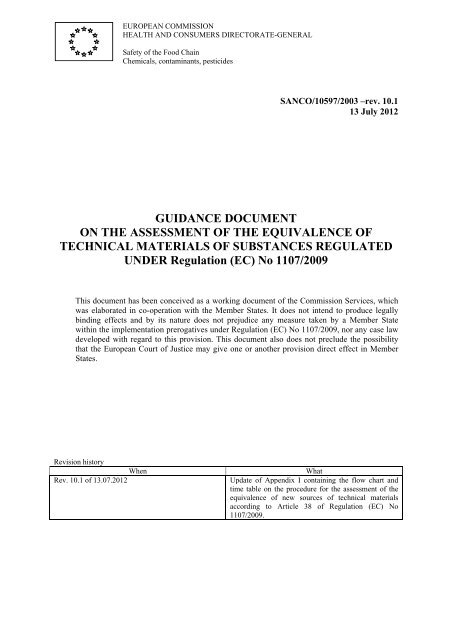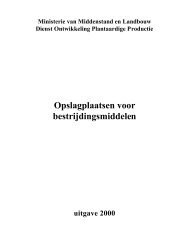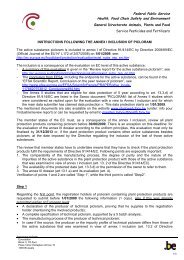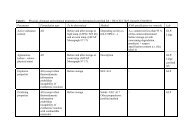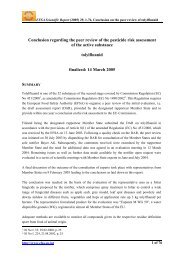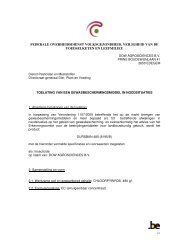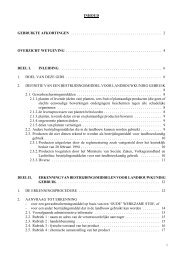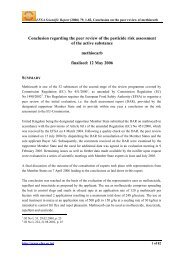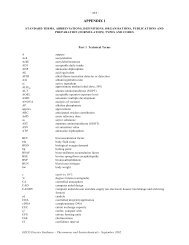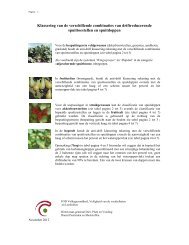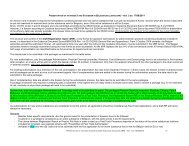Assessment of the Equivalence of Technical Materials - European ...
Assessment of the Equivalence of Technical Materials - European ...
Assessment of the Equivalence of Technical Materials - European ...
- No tags were found...
You also want an ePaper? Increase the reach of your titles
YUMPU automatically turns print PDFs into web optimized ePapers that Google loves.
EUROPEAN COMMISSIONHEALTH AND CONSUMERS DIRECTORATE-GENERALSafety <strong>of</strong> <strong>the</strong> Food ChainChemicals, contaminants, pesticidesSANCO/10597/2003 –rev. 10.113 July 2012GUIDANCE DOCUMENTON THE ASSESSMENT OF THE EQUIVALENCE OFTECHNICAL MATERIALS OF SUBSTANCES REGULATEDUNDER Regulation (EC) No 1107/2009This document has been conceived as a working document <strong>of</strong> <strong>the</strong> Commission Services, whichwas elaborated in co-operation with <strong>the</strong> Member States. It does not intend to produce legallybinding effects and by its nature does not prejudice any measure taken by a Member Statewithin <strong>the</strong> implementation prerogatives under Regulation (EC) No 1107/2009, nor any case lawdeveloped with regard to this provision. This document also does not preclude <strong>the</strong> possibilitythat <strong>the</strong> <strong>European</strong> Court <strong>of</strong> Justice may give one or ano<strong>the</strong>r provision direct effect in MemberStates.Revision historyWhenRev. 10.1 <strong>of</strong> 13.07.2012WhatUpdate <strong>of</strong> Appendix I containing <strong>the</strong> flow chart andtime table on <strong>the</strong> procedure for <strong>the</strong> assessment <strong>of</strong> <strong>the</strong>equivalence <strong>of</strong> new sources <strong>of</strong> technical materialsaccording to Article 38 <strong>of</strong> Regulation (EC) No1107/2009.
Contents1 Implementing schedule ...................................................................................................... 32 Introduction ........................................................................................................................ 33 Legal basis.......................................................................................................................... 34 Approach ............................................................................................................................ 45 Definitions.......................................................................................................................... 46 Evaluation <strong>of</strong> equivalence <strong>of</strong> technical materials (Tier I) .................................................. 56.1 Data requirements ...................................................................................................... 56.2 Evaluation process...................................................................................................... 56.3 Decision-making ........................................................................................................ 66.4 Reporting.................................................................................................................... 67 Evaluation <strong>of</strong> equivalence <strong>of</strong> technical materials (Tier II)................................................. 67.1 Toxicity ...................................................................................................................... 67.1.1 Data requirements .............................................................................................. 67.1.2 Evaluation process.............................................................................................. 77.1.3 Decision-making ................................................................................................ 97.1.4 Reporting.......................................................................................................... 107.2 Ecotoxicity ............................................................................................................... 107.2.1 Data requirements and evaluation process....................................................... 107.2.2 Decision making............................................................................................... 13Appendix I Flow chart and time table on <strong>the</strong> procedure for <strong>the</strong> assessment <strong>of</strong> <strong>the</strong>equivalence <strong>of</strong> new sources <strong>of</strong> technical materials according to Article 38 Regulation (EC) No1107/2009 (The numbering corresponds to <strong>the</strong> explanation given on <strong>the</strong> next page).............. 16Appendix Ib: Evaluation and decision making scheme in <strong>the</strong> perspective <strong>of</strong> toxicologicalassessment ...................................................................................................................... 19Appendix II Aide-memoire for sources <strong>of</strong> information that can be used to assess <strong>the</strong> toxicHAZARD <strong>of</strong> impurities............................................................................................................ 20Appendix III Impurities <strong>of</strong> known toxicological concern................................................. 22Appendix V How to judge what is an acceptable upper limit concentration for an impurity<strong>of</strong> toxicological concern........................................................................................................... 27Appendix VI Example calculations for applying <strong>the</strong> generic approach for assessingecotoxicological equivalence ................................................................................................... 29Appendix VII Evaluation report.......................................................................................... 302
1 Implementing scheduleThis amended guidance document should be implemented as from 13 July 2012.2 IntroductionAs a general principle for <strong>the</strong> same active substance <strong>the</strong> level <strong>of</strong> hazard posed for health andenvironmental protection must be comparable for different sources <strong>of</strong> technical material. Thisdocument only addresses <strong>the</strong> hazard <strong>of</strong> technical materials. If <strong>the</strong> hazard is considered to begreater for <strong>the</strong> new source than <strong>the</strong> reference source, <strong>the</strong>n an appropriate risk assessmentshould be conducted for <strong>the</strong> new source to determine whe<strong>the</strong>r plant protection productscontaining <strong>the</strong> new technical material will fulfil <strong>the</strong> safety requirements laid down in Article4(2) and (3) <strong>of</strong> Regulation (EC) No 1107/2009.This guidance document is intended to establish a harmonised procedure for assessing <strong>the</strong>equivalence <strong>of</strong> different sources <strong>of</strong> technical material versus <strong>the</strong> reference source according to<strong>the</strong> provisions stipulated in Article 38 <strong>of</strong> Regulation (EC) No 1107/2009.Any change concerning <strong>the</strong> source <strong>of</strong> <strong>the</strong> technical material after <strong>the</strong> authorisation <strong>of</strong> a plantprotection product is dealt with by Article 45 (2). The assessment <strong>of</strong> <strong>the</strong> change (e.g. newsource, amended specification, amended manufacturing process, amended manufacturinglocation) has to be conducted according to <strong>the</strong> procedure stipulated in Article 38 and thisguidance document.The purpose is to apply harmonised hazard assessment criteria to a certain technical materialwhich was not completely toxicologically and/or ecotoxicologically tested according toAnnex II <strong>of</strong> Directive 91/414/EEC. By <strong>the</strong> comparison <strong>of</strong> <strong>the</strong> specification(s) which havebeen concluded and agreed on for <strong>the</strong> reference source(s) with <strong>the</strong> correspondingspecifications for new sources or changes to those already assessed, technical materials can beconsidered as equivalent or not equivalent regarding <strong>the</strong>ir hazard potential or certain data gapscan be identified where fur<strong>the</strong>r toxicological and ecotoxicological testing is needed.This paper does not address:• <strong>Technical</strong> materials that are micro-organisms• <strong>Technical</strong> materials that are poorly-defined chemical compositions/mixtures, e.g. plantextracts, animal products and <strong>the</strong>ir derivatives3 Legal basisThe legal basis for this guidance document is <strong>the</strong> Regulation (EC) No 1107/2009 as lastamended. However, <strong>the</strong> guidance document can also be used for assessments that have to beconducted according to Directive 91/414/EEC. The given references to <strong>the</strong> requirements <strong>of</strong>Annex II and VI <strong>of</strong> 91/414/EEC have to be regarded as valid as long as <strong>the</strong> data requirementsare not adopted as stipulated in Article 78, paragraph 1 (b) and (c) <strong>of</strong> Regulation (EC) No1107/2009. If necessary <strong>the</strong> guidance document will be amended accordingly.3
4 ApproachIn this document a two-tiered approach is proposed in order to assess <strong>the</strong> equivalence <strong>of</strong>different sources <strong>of</strong> technical materials.Tier I consists <strong>of</strong> <strong>the</strong> evaluation <strong>of</strong> points 1.1- 1.11 and 4.1 <strong>of</strong> Annex IIA <strong>of</strong> <strong>the</strong> Directive91/414/EEC (evaluation <strong>of</strong> analytical data). If equivalence can be ascertained from <strong>the</strong>se data<strong>the</strong> Tier II assessment is not necessary.If equivalence cannot be established on <strong>the</strong> basis <strong>of</strong> <strong>the</strong> Tier I data, fur<strong>the</strong>r mammaliantoxicity/ecotoxicity consideration is necessary which will form <strong>the</strong> requirements <strong>of</strong> Tier II. Aschematic representation <strong>of</strong> <strong>the</strong> approach proposed is found in Appendix Ib.Evaluation ProcessThe processing <strong>of</strong> <strong>the</strong> evaluation has to be conducted according to Article 38 <strong>of</strong> <strong>the</strong>Regulation (EC) No 1107/2009. A flow chart and time table on <strong>the</strong> procedure for <strong>the</strong>assessment <strong>of</strong> <strong>the</strong> equivalence <strong>of</strong> new sources <strong>of</strong> technical materials according to Article 38Regulation (EC) No 1107/2009 is given in Appendix I.5 Definitions<strong>Equivalence</strong>If <strong>the</strong> new source has <strong>the</strong> same or less harmful effects within <strong>the</strong> meaning <strong>of</strong> Article 4(2) and(3) due to its impurities compared to <strong>the</strong> reference source, <strong>the</strong>n <strong>the</strong> new source can beconsidered (eco)toxicologically equivalent to <strong>the</strong> reference source.Reference source(s)This is <strong>the</strong> source(s) on which <strong>the</strong> risk assessment in <strong>the</strong> Draft <strong>Assessment</strong> Report was basedand for which a regulatory decision has been taken by <strong>the</strong> Commission. More than onereference source can exist if different applicants submit complete dossiers for Annex Iinclusion. In cases where an active substance is included in Annex I without a harmonisedreference specification, first <strong>of</strong> all a reference specification needs to be established accordingto SANCO/6075/2009.There could be cases where an assessment <strong>of</strong> <strong>the</strong> equivalence before <strong>the</strong> decision on inclusionin Annex I is appropriate. For example, <strong>the</strong> same applicant used different plants and <strong>the</strong> RMSconcludes that only one <strong>of</strong> <strong>the</strong> sources is <strong>the</strong> basis for <strong>the</strong> references specification.In <strong>the</strong> context <strong>of</strong> this document different sources are intended to cover <strong>the</strong> following cases:1. When technical material comes from a new/different manufacturer o<strong>the</strong>r than <strong>the</strong> applicant<strong>of</strong> <strong>the</strong> reference source.2. When <strong>the</strong> production is switched from a pilot scale to a industrial scale commercialproduction, <strong>the</strong> latter is regarded as a different source.3. When <strong>the</strong>re is a change in <strong>the</strong> method <strong>of</strong> manufacture (e.g. process or quality <strong>of</strong> startingmaterials) and/or a change <strong>of</strong> <strong>the</strong> manufacturing location, and/or <strong>the</strong> addition <strong>of</strong> one or morealternative manufacturing locations (production sites).ImpuritiesAny component o<strong>the</strong>r than <strong>the</strong> pure active substance and/or variant which is present in <strong>the</strong>technical material (including components originating from <strong>the</strong> manufacturing process or fromdegradation during storage) [Art. 3 (33) <strong>of</strong> Regulation (EC) No 1107/2009].4
Significant impuritiesImpurities that occur due to process variability 1 in quantities ≥ 1 g/kg in <strong>the</strong> active substanceas manufactured, based on dry weight, are regarded as significant.Relevant impuritiesAll impurities <strong>of</strong> toxicological and/or ecotoxicological or environmental concern 2 comparedwith <strong>the</strong> active substance, even if present in technical material at < 1 g/kg.6 Evaluation <strong>of</strong> equivalence <strong>of</strong> technical materials (Tier I)6.1 Data requirements1. <strong>Technical</strong> material coming from a new/different manufacturerThe data under points 1.1.-1.11 and 4.1 <strong>of</strong> Annex IIA <strong>of</strong> <strong>the</strong> Directive 91/414/EEC must beprovided.2. Large scale production vs. pilot scale production.The data under point 1.11 <strong>of</strong> Annex IIA <strong>of</strong> <strong>the</strong> Directive 91/414/EEC must be provided. Forpoints 1.1-1.10 a statement from <strong>the</strong> applicant is sufficient if <strong>the</strong>re are no changes.The data under point 4.1 are required if <strong>the</strong>re is a change to <strong>the</strong> impurity pr<strong>of</strong>ile or if newanalytical methods are used.3. Change in <strong>the</strong> manufacturing process, and/or manufacturing location, and/or addition <strong>of</strong>one or more alternative manufacturing locationsThe data under points 1.1.-1.11 <strong>of</strong> Annex IIA <strong>of</strong> <strong>the</strong> Directive 91/414/EEC must be provided.The data under point 4.1 are required if <strong>the</strong>re is a change to <strong>the</strong> impurity pr<strong>of</strong>ile or if newanalytical methods are used.6.2 Evaluation processFor <strong>the</strong> evaluation <strong>of</strong> equivalence <strong>of</strong> different sources against <strong>the</strong> reference source, <strong>the</strong>following criteria should be considered in <strong>the</strong> Tier I approach.The new source is deemed to be equivalent to <strong>the</strong> reference source if:• <strong>the</strong> certified minimum purity is not lower than that <strong>of</strong> <strong>the</strong> reference source (taking intoaccount <strong>the</strong> ratio <strong>of</strong> isomers, where appropriate),• no new impurities are present• <strong>the</strong> limits <strong>of</strong> relevant impurities, as certified for <strong>the</strong> reference source, are not increased and1 Significant impurities may be present as a direct result <strong>of</strong> <strong>the</strong> chemical syn<strong>the</strong>sis process/conditions employedor may be present as a result <strong>of</strong> cross contamination within <strong>the</strong> production cycle.2 Considering <strong>the</strong> Regulation, <strong>the</strong> following definition is proposed for relevant impurities: such substancesinclude, but are not limited to, substances meeting <strong>the</strong> criteria to be classified as hazardous in accordance withRegulation (EC) No. 1272/2008 [extract from Art. 3(4)] or <strong>the</strong> available information (e.g. (Q)SAR, genotoxicity)indicates that <strong>the</strong> impurity has a toxicological hazard. Relevant impurities have <strong>the</strong> inherent capacity to causeharmful/unacceptable effects within <strong>the</strong> meaning <strong>of</strong> Article 4(2) and (3). Compared to <strong>the</strong> active substance,relevant impurities show additional (or more severe) toxic properties (in <strong>the</strong> sense <strong>of</strong> <strong>the</strong> above given properties).5
• <strong>the</strong> certified limits <strong>of</strong> all non-relevant impurities, 3 as certified for <strong>the</strong> reference source, arenot exceeded by more than <strong>the</strong> following levels 4 :Certified limits <strong>of</strong> non-relevant impurities Acceptable maximum increase 5in <strong>the</strong> reference technical specifications≤ 6 g/kg3 g/kg> 6 g/kg 50% <strong>of</strong> <strong>the</strong> certified limitIn cases where <strong>the</strong>re is more than one reference source listed in Annex I, <strong>the</strong> specification <strong>of</strong><strong>the</strong> new source needs to be evaluated against <strong>the</strong> references sources individually. The newsource is regarded as equivalent as long as <strong>the</strong> criteria given above are met for one <strong>of</strong> <strong>the</strong>reference sources.6.3 Decision-makingOn <strong>the</strong> basis <strong>of</strong> <strong>the</strong> above criteria <strong>the</strong> conclusions might be that:• The new source is equivalent to <strong>the</strong> reference source, <strong>the</strong>refore no fur<strong>the</strong>r consideration isneeded• <strong>Equivalence</strong> <strong>of</strong> <strong>the</strong> new source to <strong>the</strong> reference source cannot be established based on <strong>the</strong>Tier I criteria alone, <strong>the</strong>refore a Tier II evaluation is required in order to assess whe<strong>the</strong>r<strong>the</strong> impurity pr<strong>of</strong>ile results in an unacceptable increase in <strong>the</strong> hazards <strong>of</strong> <strong>the</strong> material <strong>of</strong><strong>the</strong> new source compared to those <strong>of</strong> <strong>the</strong> reference source.• The new source is not equivalent to <strong>the</strong> reference source because <strong>the</strong> minimum purity islower than that <strong>of</strong> <strong>the</strong> reference source. In this case an appropriate risk assessment must beconducted for <strong>the</strong> new source to determine whe<strong>the</strong>r plant protection products containing<strong>the</strong> technical material will fulfil <strong>the</strong> safety requirements laid down in Article 4(2) and (3)<strong>of</strong> Regulation 1107/2009.6.4 ReportingA report must be prepared in <strong>the</strong> format in Appendix VII. If an equivalence check isperformed during <strong>the</strong> Annex I inclusion process, <strong>the</strong> confidential part <strong>of</strong> <strong>the</strong> assessment mustbe reported in Annex C (Volume 4) <strong>of</strong> <strong>the</strong> DAR.7 Evaluation <strong>of</strong> equivalence <strong>of</strong> technical materials (Tier II)7.1 Toxicity7.1.1 Data requirementsReliance should be placed on information that is already available. Only when <strong>the</strong>re isdefinite concern that <strong>the</strong> hazard from <strong>the</strong> technical a.s. could have an adverse impact shouldfur<strong>the</strong>r animal testing be conducted. The use <strong>of</strong> expert judgement is important when assessingtoxicological data. The following guidance should <strong>the</strong>refore be used as a starting point fordecision-making. Rigid adherence to guidance may not be appropriate in all cases.3 To establish if a new impurity is <strong>of</strong> toxicological/ecotoxicological concern or not it will requiretoxicological/ecotoxicological input.4 It should be noted that <strong>the</strong> intended purpose <strong>of</strong> <strong>the</strong>se levels was to harmonise <strong>the</strong> comparisons <strong>of</strong> differentspecifications and not for setting a reference specification.5 These quantitative criteria are based on <strong>the</strong>“Manual on Development and Use <strong>of</strong> FAO and WHO specificationsfor Pesticides (November 2010 - second revision <strong>of</strong> <strong>the</strong> First Edition, Rome)”6
7.1.2 Evaluation processThe objective <strong>of</strong> <strong>the</strong> evaluation is to identify whe<strong>the</strong>r <strong>the</strong>re is an unacceptable hazard increasefor <strong>the</strong> new source as compared to <strong>the</strong> reference source as a result <strong>of</strong>:• any new impurities or/and• increased levels <strong>of</strong> relevant impurities or/and• increased levels <strong>of</strong> non-relevant impurities which exceed <strong>the</strong> limits mentioned insection 5.2In <strong>the</strong> absence <strong>of</strong> appropriate test data for <strong>the</strong> new source, an unacceptable increase intoxicity, would generally be <strong>the</strong> case if, as a consequence, ei<strong>the</strong>r reference values such asADI, AOEL, or ARfD had to be lowered or a more severe hazard classification resulted. Ifappropriate data for <strong>the</strong> new source are available, <strong>the</strong> guidance at 6.1.3 should be followed.If new or increased levels <strong>of</strong> impurities are present, <strong>the</strong> applicant must provide a case and/ordata to show that <strong>the</strong> new source is not significantly more toxic than <strong>the</strong> reference source. If<strong>the</strong>re is evidence that a new or increased level <strong>of</strong> an impurity will NOT have a significantadverse effect on <strong>the</strong> toxicity <strong>of</strong> <strong>the</strong> new source compared with <strong>the</strong> reference source, <strong>the</strong> newsource is equivalent to <strong>the</strong> reference source. However, if <strong>the</strong>re is evidence that a new orincreased level <strong>of</strong> an impurity will have a significant adverse effect on <strong>the</strong> toxicity <strong>of</strong> <strong>the</strong> newsource compared with <strong>the</strong> reference source; <strong>the</strong> new source is not equivalent to <strong>the</strong> referencesource.The upper limits specified for relevant impurities <strong>of</strong> toxicological concern in <strong>the</strong> referencesource should not be exceeded. However, if this should be proposed, <strong>the</strong> applicant will needto provide a very strong case to support a) raising <strong>the</strong> upper limit concentration and b)equivalence to <strong>the</strong> reference source.a) <strong>Assessment</strong> <strong>of</strong> <strong>the</strong> toxicity <strong>of</strong> impuritiesFor <strong>the</strong> assessment <strong>of</strong> <strong>the</strong> toxicity <strong>of</strong> impurities, <strong>the</strong> considerations described below should befollowed. These considerations are also represented in <strong>the</strong> flow chart in Appendix Ib.As a first step toxicologists consider <strong>the</strong> case provided by <strong>the</strong> applicant, any available data for<strong>the</strong> impurity (as a pure substance or present as an impurity - see Appendix II) and whe<strong>the</strong>r <strong>the</strong>impurity is a structure <strong>of</strong> toxicological concern (see Appendix III). Impurities <strong>of</strong> interest(because <strong>the</strong>y are new or present at increased levels) can initially be divided into <strong>the</strong>following categories:Impurities <strong>of</strong> no toxicological concern: compounds for which <strong>the</strong> toxicity is known to be low(certain non-critical inerts, mineral salts, water, etc.). An additional toxicological evaluationwould generally not be required, but <strong>the</strong> applicant has to submit a reasoned case.Impurities <strong>of</strong> known toxicological concern: (see examples in Appendix III, which is notnecessarily exhaustive): if one <strong>of</strong> <strong>the</strong>se impurities is present in <strong>the</strong> new source but not in <strong>the</strong>reference source, very good evidence would be needed to show that it will not result insignificantly increased toxicity compared with <strong>the</strong> reference source. If convincing evidencecannot be provided, <strong>the</strong> new source is regarded as not equivalent to <strong>the</strong> reference source. If animpurity <strong>of</strong> toxicological concern was identified as a relevant impurity in <strong>the</strong> referencesource, fur<strong>the</strong>r assessment has to determine whe<strong>the</strong>r levels in <strong>the</strong> new source are stillacceptable.7
New impurities <strong>of</strong> unknown toxicological concern (>1g/kg) or increased levels <strong>of</strong> significantbut non-relevant impurities: <strong>the</strong>se impurities would elicit a fur<strong>the</strong>r evaluationAssuming suitable information is available, <strong>the</strong> competent authority considers whe<strong>the</strong>r <strong>the</strong>hazard <strong>of</strong> <strong>the</strong> new material is significantly increased compared with that <strong>of</strong> <strong>the</strong> referencesource by <strong>the</strong> presence <strong>of</strong> <strong>the</strong> impurity at <strong>the</strong> respective level 6 .If not enough information is submitted, fur<strong>the</strong>r data should be generated as indicated inAppendix IV.If worker/operator and consumer exposure to <strong>the</strong> impurity is below <strong>the</strong> threshold <strong>of</strong> concern(TTC, Kroes et al., 2004 & 2005), it may be acceptable to waive <strong>the</strong> need to generate newdata, but <strong>the</strong> applicant has to submit a reasoned case 7 . Basically it is a management decision,as to whe<strong>the</strong>r <strong>the</strong> TTC concept is sufficiently conservative to protect <strong>the</strong> population and toallow decision-making and whe<strong>the</strong>r <strong>the</strong> uncertainties due to <strong>the</strong> assumptions in this exposureestimation are acceptable.The choice <strong>of</strong> an appropriate TTC value is a case-by-case decision, which takes into accountinter alia <strong>the</strong> known/assumed properties <strong>of</strong> <strong>the</strong> impurity. Currently, fur<strong>the</strong>r advice is neededto support <strong>the</strong> choice and harmonise <strong>the</strong> approaches between <strong>the</strong> MSs. The available openliterature on <strong>the</strong> TTC concept as well as a recently submitted report by CRD could be visitedto support such considerations (Applicability <strong>of</strong> thresholds <strong>of</strong> toxicological concern in <strong>the</strong>dietary risk assessment <strong>of</strong> metabolites, degradation and reaction products <strong>of</strong> pesticides;scientific / technical report submitted to EFSA prepared by Chemicals Regulation Directorate(CRD), UK, final report Sept. 2009).b) Determination <strong>of</strong> an acceptable upper limit concentration for an impurity <strong>of</strong>toxicological concernIf an impurity <strong>of</strong> toxicological concern in <strong>the</strong> new source does not exceed an acceptable upperlimit concentration, it may help to indicate that <strong>the</strong>re is no increased hazard in <strong>the</strong> new sourcecompared with <strong>the</strong> reference source.Initially <strong>the</strong> following are examined:- Consider case presented by <strong>the</strong> applicant- Was <strong>the</strong> impurity present in <strong>the</strong> test material used in critical toxicity studies and did<strong>the</strong> findings indicate that at this concentration <strong>the</strong> impurity was not having an effect <strong>of</strong>concern?6 It is conceivable that <strong>the</strong> hazard <strong>of</strong> <strong>the</strong> new source is significantly increased by <strong>the</strong> sum <strong>of</strong> all new or increasedimpurities ra<strong>the</strong>r than by one impurity alone. In this case which is expected to occur only very seldomly,equivalence would also have to be denied.7 The maximum possible level <strong>of</strong> human exposure to <strong>the</strong> impurity can be calculated assuming that <strong>the</strong> impuritywill be present at <strong>the</strong> maximum level specified in technical grade a.s, exposure to <strong>the</strong> a.s. will be at 100 % <strong>of</strong> <strong>the</strong>a.s. reference doses (AOEL, ADI, ARfD), and that <strong>the</strong> exposed person has a bw <strong>of</strong> 70 kg.The following calculation can be applied:Exposure [µg/person/d] = RfD for a.s. [mg/kg bw/d] * 70 kg bw * specified maximum amount <strong>of</strong> impurity in <strong>the</strong>a.s. [g/kg=µg/mg].This approach makes some assumptions that may not always be met: e. g. (1) as <strong>the</strong> AOEL is a systemic value, itis presumed that dermal, oral and inhalation absorption is comparable to <strong>the</strong> a.s.; (2) <strong>the</strong> behaviour as a residue iscomparable to <strong>the</strong> a.s.8
If <strong>the</strong> answer is yes, it might be appropriate to use <strong>the</strong> level <strong>of</strong> <strong>the</strong> impurity in <strong>the</strong> testedmaterial as <strong>the</strong> acceptable upper limit concentration but expert judgement will be particularlyimportant.If <strong>the</strong> answer is no, consider <strong>the</strong> guidance in Appendix IV and V.Note: <strong>the</strong> limit for a relevant impurity may be set at a level less than 1 g/kg (
Irrespective <strong>of</strong> <strong>the</strong> above three paragraphs, if a more severe hazard classification is necessaryfor <strong>the</strong> new source compared to <strong>the</strong> reference source, equivalence can not be stated.7.1.4 ReportingA report must be prepared in <strong>the</strong> currently available format (see Appendix VII)7.2 Ecotoxicity7.2.1 Data requirements and evaluation processIn analogy to <strong>the</strong> toxicity evaluation process, <strong>the</strong> objective is to identify whe<strong>the</strong>r <strong>the</strong>re is anunacceptable increase in <strong>the</strong> ecotoxicity <strong>of</strong> <strong>the</strong> new source caused by new impurities and/orsignificantly increased levels <strong>of</strong> impurities already present in <strong>the</strong> reference substance(compare chapter 6.1.2).If new or increased levels <strong>of</strong> impurities are present, <strong>the</strong> applicant must provide a case and/ordata to show that <strong>the</strong> new source is not significantly more ecotoxic than <strong>the</strong> reference source.If <strong>the</strong>re is evidence that a new or increased level <strong>of</strong> an impurity will NOT have a significantadverse effect on <strong>the</strong> ecotoxicity <strong>of</strong> <strong>the</strong> new source compared with <strong>the</strong> reference source, <strong>the</strong>new source is equivalent to <strong>the</strong> reference source. However, if <strong>the</strong>re is evidence that a new orincreased level <strong>of</strong> an impurity will have a significant adverse effect on <strong>the</strong> ecotoxicity <strong>of</strong> <strong>the</strong>new source compared with <strong>the</strong> reference source, <strong>the</strong> new source is not equivalent to <strong>the</strong>reference source.The assessment <strong>of</strong> <strong>the</strong> ecotoxicity <strong>of</strong> impurities should, in principle, address all organism taxaand endpoints given in Directive 91/414/EEC, Annex II chapter 8 (i.e., a change in <strong>the</strong>composition <strong>of</strong> <strong>the</strong> active substance should not lead to a higher hazard to any species in <strong>the</strong>environment) and <strong>the</strong>reupon follow similar considerations as described for <strong>the</strong> toxicologyassessment in chapter 6.1.2 a) and b). However, <strong>the</strong> existing differences in assessmentstrategies between toxicology and ecotoxicology imply a different weighting <strong>of</strong> possibleapproaches for performing assessments in situations with few available experimental data onecotoxicity. In particular, <strong>the</strong> use <strong>of</strong> SAR or QSAR approaches is limited by <strong>the</strong> loweravailability <strong>of</strong> reliable models for <strong>the</strong> whole spectrum <strong>of</strong> taxonomic groups occurring in <strong>the</strong>environment.10
a) Prediction <strong>of</strong> <strong>the</strong> expected increase in toxicity for assessing <strong>the</strong> ecotoxicologicalrepresentativenessA generic approach based on <strong>the</strong> pharmacological reference concept <strong>of</strong> concentrationadditivity (Loewe & Muischnek, 1926; Finney, 1971; Kortenkamp et al.., 2010) is suggestedas <strong>the</strong> preferred choice in cases where experimental ecotoxicity data on <strong>the</strong> new source orspecific impurities are lacking. This concept postulates a strictly similar mode-<strong>of</strong>-action (on<strong>the</strong> molecular scale) <strong>of</strong> <strong>the</strong> mixture component, whereas <strong>the</strong> individual potency (efficacy) canvary. For a multi-component system <strong>of</strong> n compounds, <strong>the</strong> concept allows a prediction <strong>of</strong>mixture effect concentrations based on single-compound effect concentrations according to<strong>the</strong> following equation.ECx( mix)() i()⎛ p= ⎜∑ n⎝ i ECxi⎞⎟⎠−1(1)with:n = number <strong>of</strong> mixture componentsi = index from 1…n, assigns <strong>the</strong> mixture componentsmix = mixtureEC x = concentration causing x % effectp(i) = relative fraction <strong>of</strong> <strong>the</strong> i-th component in <strong>the</strong> mixtureApplication for a binary mixture ABThe scenario refers to a binary mixture AB consisting <strong>of</strong> <strong>the</strong> impurity to be assessed, A at anamount <strong>of</strong> p(A) and <strong>the</strong> active substance, B (in this context: sum <strong>of</strong> all o<strong>the</strong>r mixturecomponents) at an amount <strong>of</strong> p(B) = 1 – p(A). If it is assumed that <strong>the</strong> toxicity <strong>of</strong> <strong>the</strong> impuritycompound A is higher by a factor <strong>of</strong> f than <strong>the</strong> active-substance compound B, <strong>the</strong> followingequation can be derived.ECx( AB)× ECx( A)( −1) × p( A) + 1= ff(2)If a value is known for <strong>the</strong> toxicity <strong>of</strong> <strong>the</strong> impurity compound A, this can be used forcalculating <strong>the</strong> factor f based on <strong>the</strong> also already known value for <strong>the</strong> overall toxicity <strong>of</strong> <strong>the</strong>mixture AB as follows.( B)( A)( AB) − p( A) × ECx( AB)( A) − p( A) × EC ( AB)ECxECxf = =(3)EC ECxxxCare must be taken that <strong>the</strong> effect concentrations <strong>of</strong> all individual compounds for an endpoint<strong>of</strong> interest are obtained under identical or at least largely similar test conditions (species, testduration, type <strong>of</strong> exposure, etc.), in order to allow <strong>the</strong> equation to be used. If suchexperimental values for effect concentrations do not exist, it is possible as an alternativeoption to estimate <strong>the</strong> order <strong>of</strong> magnitude <strong>of</strong> unknown effect concentrations using a validatedQSAR model. The applicability <strong>of</strong> a certain model for <strong>the</strong> concrete case must always besubstantiated.11
Prediction <strong>of</strong> <strong>the</strong> toxicity <strong>of</strong> a binary mixture AB new in relation to a mixture AB oldOn <strong>the</strong> same foundations, a comparison <strong>of</strong> predicted effect values for overall toxicitydepending on <strong>the</strong> content <strong>of</strong> <strong>the</strong> impurity component A is possible (even without knowledgeon <strong>the</strong> actual toxicity <strong>of</strong> all mixture components).ECECx( ABold)( AB )xnew( f −1) × pnew( A)+( −1) × p ( A) + 1= fold1(4)The result <strong>of</strong> this calculation depends, on <strong>the</strong> one hand, on <strong>the</strong> respective content <strong>of</strong> <strong>the</strong>impurity component A in <strong>the</strong> “old” and <strong>the</strong> “new” mixture (i.e. reference and new source)and, on <strong>the</strong> o<strong>the</strong>r hand, on <strong>the</strong> factor f, by which <strong>the</strong> impurity component A is more toxic (oris assumed to be more toxic) than <strong>the</strong> active-substance component B.<strong>Assessment</strong> <strong>of</strong> <strong>the</strong> relevance <strong>of</strong> impuritiesFor all ecotoxicological assessment areas, where <strong>the</strong> new source is different from <strong>the</strong> batchesused in ecotoxicological testing according to <strong>the</strong> Tier I assessment, <strong>the</strong> predicted increase inecotoxicity <strong>of</strong> <strong>the</strong> new source must be calculated based on its actual composition (equation 4),unless a comparison <strong>of</strong> ecotoxicity is possible based on experimental data (see below). Thefollowing cases are distinguished with regard to <strong>the</strong> selection <strong>of</strong> a value for <strong>the</strong> factor f.- A factor f = 100 is applied by default. This reflects a conservative approach in caseswhere <strong>the</strong> toxic action <strong>of</strong> <strong>the</strong> technical active substance against <strong>the</strong> organismconsidered is not determined by <strong>the</strong> intended pesticidal mode-<strong>of</strong>-action (e.g., effectson fish through a herbicide) or ano<strong>the</strong>r known specific mechanism. In such cases, astrong impact <strong>of</strong> an impurity compound on <strong>the</strong> overall toxicity <strong>of</strong> a technical activesubstance against <strong>the</strong> tested organism cannot be excluded with sufficient certainty.- The factor may be lowered to f = 10 where it can be plausibly assumed that <strong>the</strong> toxicaction <strong>of</strong> <strong>the</strong> technical active substance against <strong>the</strong> tested organism is determined by<strong>the</strong> intended pesticidal mode-<strong>of</strong>-action (e.g., effects <strong>of</strong> a herbicide on algae) or whereexisting knowledge (e.g., typical toxicity pr<strong>of</strong>iles <strong>of</strong> classes <strong>of</strong> active substances)confirms that a specific toxic mechanism <strong>of</strong> <strong>the</strong> active substance against <strong>the</strong> testedorganism may be assumed.b) <strong>Assessment</strong> <strong>of</strong> bridging studies in order to prove ecotoxicological representativenessIf studies exist that allow a direct comparison <strong>of</strong> <strong>the</strong> ecotoxicity <strong>of</strong> a new source against <strong>the</strong>ecotoxicity <strong>of</strong> a reference batch, <strong>the</strong> results from <strong>the</strong>se studies should be used for assessing <strong>the</strong>equivalence <strong>of</strong> a new source and reference batch. As a prerequisite for such an assessment,both studies must be carried out according to <strong>the</strong> same testing methodology, under identicalexposure conditions (e.g., static, flow-through) and with <strong>the</strong> same test species.Fur<strong>the</strong>rmore, bridging is only possible between groups <strong>of</strong> organisms where it can be assumedthat <strong>the</strong> effects <strong>of</strong> <strong>the</strong> test substance in both groups are caused by <strong>the</strong> same mode-<strong>of</strong>-action. In<strong>the</strong> case, e.g., <strong>of</strong> a herbicidal active substance, bridging is usually only possible betweenaquatic plants, but not from aquatic plants to invertebrates.Bridging between acute and prolonged testing is in principle possible. If a study indicates that<strong>the</strong> acute toxicity <strong>of</strong> <strong>the</strong> new source mixture is determined by <strong>the</strong> pure active substance, it isconsidered unlikely that effect levels on <strong>the</strong> prolonged time scale will be determined by <strong>the</strong>impurity.12
Bridging across different media (e.g., from aquatic to terrestrial insects) is possible based on acase-by-case decision, if <strong>the</strong> comparability <strong>of</strong> effect characteristics (mode-<strong>of</strong>-action anduptake) is plausibly founded.Limit tests may be appropriate for bridging purposes when it can be ensured that <strong>the</strong>uncertainty around <strong>the</strong> measured effect level fully lies within <strong>the</strong> range <strong>of</strong> <strong>the</strong> acceptabledeviation (see 6.2.2) from <strong>the</strong> effect level in <strong>the</strong> corresponding test with <strong>the</strong> reference source.7.2.2 Decision makingThe generic approach under 6.2.1 a) should be applied in all cases where no experimentalecotoxicity data or reliable modelled ecotoxicity values are available for <strong>the</strong> new source. As aresult <strong>of</strong> such an assessment, an impurity must be considered relevant and hence <strong>the</strong> newsource considered not equivalent when <strong>the</strong> increase <strong>of</strong> predicted ecotoxicity according to <strong>the</strong>calculation for <strong>the</strong> new source as compared to <strong>the</strong> reference specification for <strong>the</strong> respectiveorganism group (birds, small mammals, aquatic organisms, non-target arthropods, soilorganisms, terrestrial non-target plants) exceeds a factor <strong>of</strong> 2. To finally conclude on <strong>the</strong>relevance, bridging studies as described under 6.2.1 b) are <strong>the</strong>n typically necessary. As longas <strong>the</strong> predicted increase in ecotoxicity remains smaller than a factor <strong>of</strong> 2, <strong>the</strong> impurity isconsidered not relevant and hence <strong>the</strong> new source considered equivalent. In this case, it can beassumed with sufficient certainty that <strong>the</strong> increased content <strong>of</strong> <strong>the</strong> impurity compound in <strong>the</strong>new source will not cause a serious increase in <strong>the</strong> ecotoxicity <strong>of</strong> this new source compared to<strong>the</strong> respective batches used in ecotoxicological testing for <strong>the</strong> assessment <strong>of</strong> <strong>the</strong> referencesource.Example calculations to illustrate <strong>the</strong> application <strong>of</strong> <strong>the</strong> generic approach are attached inAppendix VI.Where experimental or reliable modelled data are available for <strong>the</strong> new source, <strong>the</strong>ecotoxicological pr<strong>of</strong>ile will be considered equivalent to that <strong>of</strong> <strong>the</strong> reference pr<strong>of</strong>ile where<strong>the</strong> ecotoxicological data provided on <strong>the</strong> technical a.s. do not differ by more than a factor <strong>of</strong>3 compared to <strong>the</strong> reference (or by <strong>the</strong> appropriate spacing factor <strong>of</strong> <strong>the</strong> respective test system,if greater than 3), when determined using <strong>the</strong> same species. (Note: this factor is meant toaccount for <strong>the</strong> variability <strong>of</strong> ecotoxicological test results and must not be interpreted as if anactual difference in ecotoxicity with a factor < 3 was in principle irrelevant with regard to <strong>the</strong>risk assessment).13
ReferencesECETOC (2003): (Q)SARs: evaluation <strong>of</strong> <strong>the</strong> commercially available s<strong>of</strong>tware for humanhealth and environmental endpoints with respect to chemical management applications.<strong>Technical</strong> Report No. 89. <strong>European</strong> Centre for Ecotoxicology and Toxicology <strong>of</strong> Chemicals,Brussels.ECB (2003): Use <strong>of</strong> (Quantitaive) Structure Activity Relationships ((Q)SAR) in Risk<strong>Assessment</strong>, in: <strong>Technical</strong> Guidance Document on Risk <strong>Assessment</strong> in Support <strong>of</strong>Commission Directive 93/67/EEC on Risk <strong>Assessment</strong> for new notified substances,Commission Regulation (EC) No. 1488/94 on Risk <strong>Assessment</strong> for existing substances,Directive 98/8/EC <strong>of</strong> <strong>the</strong> <strong>European</strong> Parliament and <strong>of</strong> <strong>the</strong> Council concerning <strong>the</strong> placing <strong>of</strong>biocidal products on <strong>the</strong> market, Part III, Chapter 4, <strong>European</strong> Commission, Joint ResearchCentre, Institute for Health and Consumer Protection, <strong>European</strong> Chemicals Bureau.Tennant RW and Ashby J (1991): Classification according to chemical structure,mutagenicity to Salmonella and level <strong>of</strong> carcinogenicity <strong>of</strong> a fur<strong>the</strong>r 39 chemicals tested forcarcinogenicity by <strong>the</strong> US National Toxicology program. Mutation Research 257, 209-227.Ashby J and Tennant RW (1991): Definitive relationships among chemical structure,carcinogenicity and mutagenicity for 301 chemicals tested by <strong>the</strong> U.S. NTP. MutationResearch 257, 229-306.Van den Berg, M., et al (1998): Toxic Equivalency Factors (TEFs) for PCBs, PCDDs, PCDFsfor humans and wildlife. Environmental Health Perspective, 106 (12), 775-792.Van den Berg, M., et al. (2006): The 2005 World Health Organisation reevaluation <strong>of</strong> humanand mammalian toxic equivalency factors for dioxins and dioxin-like compounds.Toxicological Sciences, 93 (2), 223-241WHO/FAO (2010) Manual on development and use <strong>of</strong> FAO and WHO specifications forpesticides. November 2010 – second revision <strong>of</strong> <strong>the</strong> First Edition, Prepared by <strong>the</strong> FAO/WHOJoint Meeting on Pesticide Specifications (JMPS), available only on <strong>the</strong> internet WHO andFAO, RomeKroes R, Renwick AG, Cheeseman M, Kleiner J, Mangelsdorf I, Piersma A, Schilter B,Schlatter J, van Schothorst F, Vos JG, Wurtzen G (2004) Structure-based thresholds <strong>of</strong>toxicological concern (TTC): guidance for application to substances present at low levels in<strong>the</strong> diet. Food Chem Toxicol (42) 65-83Kroes R, Kleiner J, Renwick A (2005) The threshold <strong>of</strong> toxicological concern concept in riskassessment. Toxicol Sci (86) 226-230Finney, D.J. (1971): Probit Analysis, 3rd ed. Cambridge University Press, London.Kortenkamp, A., Backhaus, T., Faust, M. (2010): State <strong>of</strong> <strong>the</strong> Art Report on Mixture Toxicity.Report for <strong>the</strong> <strong>European</strong> Commission, DG Environment, Study Contract Number070307/2007/485103/ETU/D.1. Available online underhttp://ec.europa.eu/environment/chemicals/pdf/report_Mixture%20toxicity.pdf14
Loewe, S, Muischnek, H. (1926). Über Kombinationswirkungen I. Mitteilung: Hilfsmittel derFragestellung [On combined actions I., memorandum: an aid to posing questions]. Naunyn-Schmiedebergs Arch. Exp. Pathol. Pharmakol. 114, 313–326.15
Appendix I Flow chart and time table on <strong>the</strong> procedure for <strong>the</strong> assessment <strong>of</strong> <strong>the</strong>equivalence <strong>of</strong> new sources <strong>of</strong> technical materials according to Article 38Regulation (EC) No 1107/2009 (The numbering corresponds to <strong>the</strong>explanation given on <strong>the</strong> next page).Evaluation necessary ?1YesNoPrepare report2Distribution for commenting toCOM, MS and applicant3&4Summarise comments, take into consideration and informCOM, MS and applicantNo objections to <strong>the</strong> equivalenceassessmentDisagreement from an MS(examining <strong>the</strong> application) or <strong>the</strong>RMS on <strong>the</strong> equivalenceassessment5COM presentsresults to SCFCAHThe MSs try toreach anagreement6The agreementshould becommunicated toCOM, MS andapplicantNo agreementpossible, <strong>the</strong>matter needs tobe submitted toCOM16
1. Ascertainment <strong>of</strong> <strong>the</strong> necessity to conduct an assessment on <strong>the</strong> equivalence directlyafter receiving <strong>the</strong> application. It is <strong>of</strong> interest that <strong>the</strong> intention <strong>of</strong> a MS to conduct <strong>the</strong>equivalence assessment <strong>of</strong> a specific source appears in <strong>the</strong> table <strong>of</strong> ‘equivalent sourcesand compliance checks’ on CIRCA. Therefore, as soon as a MS (Rapporteur MemberState (RMS) or Designated Member State (DMS)) agrees to conduct an equivalenceassessment, this should be communicated to <strong>the</strong> responsible contact point 12 and COM(in copy) by e-mail toge<strong>the</strong>r with a ‘completed row’ (Excel file template) containing<strong>the</strong> relevant information on <strong>the</strong> application, in order to enable an update <strong>of</strong> <strong>the</strong> table.An up-to-date template can be found on CIRCA(https://circa.europa.eu/Members/irc/sanco/pest/library?l=/technical_evaluation/overview_tables/equivalence_templatexls/_EN_1.0_&a=d).2. The RMS/DMS has to prepare <strong>the</strong> report on equivalence within 60 days fromreceiving <strong>the</strong> application (This should include <strong>the</strong> possibility for <strong>the</strong> applicant tosubmit comments).3. The report has to be communicated to <strong>the</strong> COM, <strong>the</strong> o<strong>the</strong>r Member States and <strong>the</strong>applicant. The report is placed on CIRCA. This is communicated to relevant contactpoints by e-mail toge<strong>the</strong>r with <strong>the</strong> deadline for comments. However, <strong>the</strong>confidentiality <strong>of</strong> business and trade secrets has to be guaranteed in cases where <strong>the</strong>applicant under consideration is differrent to <strong>the</strong> one <strong>of</strong> <strong>the</strong> references source.4. Within 30 days <strong>the</strong> COM, <strong>the</strong> MS and <strong>the</strong> applicant should send <strong>the</strong>ir comments to <strong>the</strong>DMS/RMS.5.1 In <strong>the</strong> case <strong>of</strong> a positive conclusion on equivalence and where no objection to thisconclusion has been raised, <strong>the</strong> conclusion should be communicated within 10 daysafter <strong>the</strong> deadline (for commenting) to <strong>the</strong> COM and <strong>the</strong> Member States. If required,<strong>the</strong> initial report on CIRCA is replaced by a revised version that takes into account <strong>the</strong>comments received. For <strong>the</strong> report <strong>the</strong> following naming convention should be usedwhen uploading on CIRCA: “active substance equivalence Notifier Source (City) MSDate "draft" resp. "final".A reporting table that summarizes all comments on <strong>the</strong> equivalence report should beuploaded on CIRCA (in <strong>the</strong> same folder as <strong>the</strong> equivalence report). Each commentshould be addressed by <strong>the</strong> RMS/DMS and non-adoption <strong>of</strong> comments should beproperly justified.12 The e-mail should be sent to equivalence@health.belgium.be. Please be sure to use <strong>the</strong> proper template (seeCIRCA).17
The outcome <strong>of</strong> <strong>the</strong> peer-reviewed equivalence assessment should be communicated to<strong>the</strong> relevant contact points and <strong>the</strong> table <strong>of</strong> ‘equivalent sources and compliancechecks’ on CIRCA should be updated accordingly 12 .5.2 Where an MS examining <strong>the</strong> application does not agree with <strong>the</strong> conclusion <strong>of</strong> <strong>the</strong>rapporteur MS or vice versa, <strong>the</strong> RMS/DMS shall inform <strong>the</strong> applicant, <strong>the</strong> o<strong>the</strong>r MSand <strong>the</strong> Commission stating its reasons. A reporting table that summarizes allcomments on <strong>the</strong> equivalence report should be uploaded on CIRCA (in <strong>the</strong> samefolder as <strong>the</strong> equivalence report). Each comment should be addressed by <strong>the</strong>RMS/DMS and non-adoption <strong>of</strong> comments should be properly justified.[It should be noted that disagreement on <strong>the</strong> assessment by ano<strong>the</strong>r MS than <strong>the</strong> RMSor <strong>the</strong> MS examining <strong>the</strong> application does not necessarily lead to step 6.For <strong>the</strong> sake <strong>of</strong> feasibility though, all MS should express <strong>the</strong>ir concerns in step 4 and<strong>the</strong> DMS/RMS should take <strong>the</strong>m into consideration even if this is not requiredaccording to Art. 38, paragraph 3.]6. The MS concerned shall try to reach agreement on <strong>the</strong> assessment. They shall provide<strong>the</strong> applicant with an opportunity to submit comments. Where <strong>the</strong> MSs concerned donot reach agreement within 45 days, <strong>the</strong> MS assessing equivalence shall submit <strong>the</strong>matter to <strong>the</strong> COM. The COM shall present <strong>the</strong> results to <strong>the</strong> SCFCAH.7. Before <strong>the</strong> COM adopts a decision according to <strong>the</strong> regulatory procedure referred to inArticle 79, paragraph 3, <strong>the</strong> COM may ask <strong>the</strong> EFSA for an opinion, or for scientificor technical assistance.18
Appendix Ib: Evaluation and decision making scheme in <strong>the</strong> perspective <strong>of</strong> toxicologicalassessmentTier INew technical a.s. isequivalent<strong>Equivalence</strong> cannot beestablished based onTier I criteriaNew technical a.s. isnot equivalentObviously non-toxic ?yesImpurity indicatesequivalence <strong>of</strong>technical a.s.Tier IInoyesSubstance <strong>of</strong> particular concern?nono dataavailable to decideNeed forfur<strong>the</strong>r dataqualitativeconcern(Eco)toxicological assessmentbased on existinginformation/data, (Q)SARsnoconcern(optional)poor data baseyesExposure < TTC ?noIs <strong>the</strong>re an acceptable maximumlevel without concern ?noyes (specify)Is <strong>the</strong> acceptable maximumlevel exceeded ?noyesIs <strong>the</strong> toxicological pr<strong>of</strong>ile <strong>of</strong> <strong>the</strong>technical a.s. changed to anunacceptable extent ?yesnoImpurity indicatesnon-equivalence<strong>of</strong> technical a.s.19
Appendix II Aide-memoire for sources <strong>of</strong> information that can be used to assess <strong>the</strong>toxic HAZARD <strong>of</strong> impuritiesThis aide-memoire can be used when considering a case provided by <strong>the</strong> applicant.Test data: applicant may have tested <strong>the</strong> impurity ei<strong>the</strong>r in isolation or in a batch <strong>of</strong> <strong>the</strong> activesubstance.Safety data sheets: if <strong>the</strong> impurity is a substance used in <strong>the</strong> manufacture <strong>of</strong> <strong>the</strong> pesticide oris a stabiliser, <strong>the</strong> applicant may have provided a safety data sheet for <strong>the</strong> substance (if not <strong>the</strong>applicant can be asked to provide one).Also consider whe<strong>the</strong>r <strong>the</strong> impurity is structurally and/or metabolically related to a substanceused in <strong>the</strong> manufacture <strong>of</strong> <strong>the</strong> pesticide (a safety data sheet should be available for asubstance used in <strong>the</strong> manufacture <strong>of</strong> <strong>the</strong> pesticide).C and L: classification and labelling information may be available on <strong>the</strong> impurity, i.e. inAnnex VI to regulation (EC) No 1272/2008 (which is updated from time to time by an ATP=Adaptation to <strong>Technical</strong> Progress) or in a draft ATP to this Directive.Literature search: applicant may have conducted a literature search for toxicity data on <strong>the</strong>impurity(Q)SAR: applicant may have conducted SAR analysis on <strong>the</strong> impurity using a recognisedcommercial database eg. DEREK. However, <strong>the</strong> limitations <strong>of</strong> SAR analysis should berecognised. For instance, with respect to <strong>the</strong> hazard and risk assessment <strong>of</strong> chemicals,ECETOC (2003) concludes that “current commercially available (Q)SAR models are <strong>of</strong>limited to good applicability for in vitro mutagenicity, limited applicability for acute oraltoxicity, skin and eye irritancy and skin sensitisation and very limited applicability for chronictoxicity, carcinogenicity and teratogenicity”. ECETOC does however acknowledge that(Q)SARs can provide warnings/alerts and that <strong>the</strong>y are more reliable for chemicals <strong>of</strong> highstructural similarity, common action mechanisms or single mechanistic steps. In addition, itshould be noted that at <strong>the</strong> present stage <strong>of</strong> <strong>the</strong>ir development, most (Q)SARs available aresuitable only for predicting toxicity, but not for <strong>the</strong> absence <strong>of</strong> it.Ideally, (Q)SARs which are used for toxicological reasoning in <strong>the</strong> context <strong>of</strong> this documentwould be validated at <strong>the</strong> EU level and well-documented especially in terms <strong>of</strong> <strong>the</strong>irapplicability domain, and (in <strong>the</strong> case <strong>of</strong> quantitative relationships) <strong>the</strong> statistical method usedfor <strong>the</strong>ir development along with <strong>the</strong> associated statistical uncertainty. Fur<strong>the</strong>r information on<strong>the</strong> use <strong>of</strong> (Q)SARs in <strong>the</strong> frame <strong>of</strong> risk assessment can be obtained from ECB (2003) and on<strong>the</strong> internet pages <strong>of</strong> <strong>the</strong> JRC Institute for Health and Consumer Protection (Ex-ECB) athttp://ecb.jrc.ec.europa.eu/qsar/.Fur<strong>the</strong>r information on QSAR and <strong>the</strong> OECD QSAR toolbox can be obtained athttp://www.oecd.org/document/23/0,3746,en_2649_34377_33957015_1_1_1_1,00.htmlInformation on QSARs in REACH is also available from ECHA(http://guidance.echa.europa.eu/guidance_en.htm): especially chapters R.6 (QSARs andgrouping <strong>of</strong> chemicals) and R.7 (Endpoint specific guidance) in <strong>the</strong> “Guidance on informationrequirements and chemical safety assessment” give details on non-testing approaches.Chemical class <strong>of</strong> concern: does <strong>the</strong> impurity belong to a chemical class <strong>of</strong> well-knowntoxicological concern, such as nitrosamines, dioxins, oxygen analogues <strong>of</strong> organophosphates,etc? To answer this question, check <strong>the</strong> list <strong>of</strong> toxicologically significant impurities in20
Appendix III, which is based on a list produced by <strong>the</strong> Australian Pesticides and VeterinaryMedicines Authority.Tennant and Ashby model: does <strong>the</strong> impurity contain a structural alert for DNA reactivityaccording to <strong>the</strong> model <strong>of</strong> Tennant and Ashby (1991)? This model indicates whe<strong>the</strong>r <strong>the</strong>re arestructures <strong>of</strong> genotoxic concern. However, <strong>the</strong> absence <strong>of</strong> structural alerts in an impurityshould not be used in isolation to argue that <strong>the</strong> impurity is unlikely to be <strong>of</strong> genotoxicconcern.Rat metabolites: If <strong>the</strong> impurity is also a rat/mammalian metabolite <strong>of</strong> <strong>the</strong> a.s. and producedin significant amounts, <strong>the</strong>n <strong>the</strong> toxicity <strong>of</strong> this impurity should have been assessed in toxicitystudies with <strong>the</strong> a.s..Similarity to a.s./metabolites: how similar is <strong>the</strong> structure <strong>of</strong> <strong>the</strong> impurity to <strong>the</strong> a.s and/or tomammalian metabolites <strong>of</strong> <strong>the</strong> a.s. produced in significant quantities? Close structuralsimilarity might be used to support an argument <strong>of</strong> similar toxicity. A very different structurewould indicate that <strong>the</strong> impurity might differ considerably in its toxicity to <strong>the</strong> parent and/orits mammalian metabolites e.g. impurities <strong>of</strong> an organophosphate a.s. that lack <strong>the</strong> AChEreactivemoiety would be expected to be less neurotoxic than <strong>the</strong> a.s.However, in <strong>the</strong> absence <strong>of</strong> a generally accepted definition <strong>of</strong> ‘structural similarity’, suchconsiderations have to be performed with great care. They should be limited to cases where<strong>the</strong> mode <strong>of</strong> (toxic) action <strong>of</strong> <strong>the</strong> substance to whose chemical structure <strong>of</strong> <strong>the</strong> impurity underquestion is compared, is clearly linked to a certain structural fragment.Metabolism/excretion: consider <strong>the</strong> ease with which <strong>the</strong> impurity might be excreted (asreflected by its polarity/size) and/or metabolised. Ready excretion might be used as anargument for reducing toxicological concern (although not necessarily if <strong>the</strong> site <strong>of</strong> excretionis <strong>the</strong> expected site <strong>of</strong> toxicity).Fur<strong>the</strong>r toxicity data: can be requested on <strong>the</strong> impurity and/or on a batch <strong>of</strong> a.s. containingappropriate levels <strong>of</strong> <strong>the</strong> impurity. However a fur<strong>the</strong>r study should only be requested if it isconsidered absolutely essential, especially if it involves animal testing.Consider alternatives to experiments on mammals such as in vitro mechanistic studies (e.g.assay for anticholinesterase activity) or assays for pesticidal activity. Assays for pesticidalactivity might be appropriate if <strong>the</strong> mechanism <strong>of</strong> pesticidal activity is considered relevant tocritical toxic effects <strong>of</strong> <strong>the</strong> a.s. (in such an assay <strong>the</strong> pesticidal activity <strong>of</strong> <strong>the</strong> a.s. could becompared with that <strong>of</strong> <strong>the</strong> impurity <strong>of</strong> interest). An assay for pesticidal activity is likely to bemost useful when <strong>the</strong> a.s. is an insecticide which acts on <strong>the</strong> nervous system <strong>of</strong> <strong>the</strong> pest.Results should be interpreted using expert judgement as ano<strong>the</strong>r type <strong>of</strong> toxicity might beassociated with <strong>the</strong> impurity.21
Appendix III Impurities <strong>of</strong> known toxicological concernThis listing, which is based on one produced by <strong>the</strong> Australian Pesticides and VeterinaryMedicines Authority (APVMA), is not considered to be exhaustive. Impurities <strong>of</strong> particularconcern are highlighted by bold text.2,3-Diaminophenazine (DAP) and 2-amino-3-hydroxyphenazine (AHP)Anilines and substituted anilines*Dichlorodiphenyltrichloroethane (DDT) and DDT related impuritiesEthylene thiourea (ETU) and propylene thioureaHalogenated dibenzodioxins and halogenated dibenz<strong>of</strong>uransHexachlorobenzene (HCB)Methyl isocyanate (any isocyanate is <strong>of</strong> potential concern)NitrosaminesOxygen analogues <strong>of</strong> organophosphatesPolychlorinated biphenyls (PCBs)Hydrazine and substituted hydrazineTetrachloroazobenzene (TCAB) and tetrachloroazoxybenzene (TCAOB)Tetraethyl dithiopyrophosphate (Sulfotep) and tetraethyl monothiopyrophosphate (O,S-TEPP)Phenols and substituted phenols** This may be too broad a grouping, i.e. it may not always be <strong>of</strong> particular toxicological concern. For instance,in regulation (EC) 1272/2008 (Annex VI, Table 3.2) phenol is classified for acute and repeated dose toxicity,corrosion and mutagenicity.Acceptable maximum concentrations <strong>of</strong> nitrosaminesThere are three types <strong>of</strong> nitrosamines: N-NO (N-nitrosamines), C-NO and O-NO. N-nitrosamines are known to be <strong>of</strong> particular toxicological concern because <strong>the</strong>y can beactivated to genotoxic carcinogens.If analytical results indicate that total nitrosamine levels exceed 1 mg/kg in <strong>the</strong> technicalmaterial, <strong>the</strong> following toxicological requirements must be addressed:i) A reasoned case primarily addressing <strong>the</strong> genotoxicity and carcinogenicity <strong>of</strong> <strong>the</strong>constituent nitrosamines (this is always required)ii) Mutagenicity data relating to specific nitrosamines (N-nitroso compounds) present in <strong>the</strong>proposed technical material; this should include appropriately conducted in vitro mutagenicity22
tests with information provided on <strong>the</strong> suitability <strong>of</strong> <strong>the</strong> exogenous metabolising fractions(s)used, and/oriii) Toxicity data on batches <strong>of</strong> an active substance containing higher levels <strong>of</strong> <strong>the</strong> samenitrosamine(s) for which approval is being sought.The overall objective is to reduce <strong>the</strong> total level <strong>of</strong> N-nitrosamines, which have <strong>the</strong> potentialto be mutagenic, to below 1 mg/kg.Acceptable maximum concentrations <strong>of</strong> polychlorinated dibenzo-p-dioxins (PCDDs),polychlorinated dibenz<strong>of</strong>urans (PCDFs) and polychlorinated biphenyls (PCBs):2,3,7,8-Tetrachlordibenzo-p-dioxin (TCDD) is considered to be <strong>the</strong> most toxic dioxin. Thetoxicity <strong>of</strong> individual dioxin, furan and PCB impurities can be related to <strong>the</strong> toxicity <strong>of</strong> TCDDto produce individual ‘TCDD toxic equivalents’. Toxic Equivalency Factors (TEFs) havebeen proposed for PCDDs, PCDFs and PCBs by WHO, see table below.The concentration <strong>of</strong> each <strong>of</strong> <strong>the</strong>se listed compounds present as an impurity is multiplied by<strong>the</strong> TEF to produce a TCDD toxic equivalent (TEQ). The sum <strong>of</strong> <strong>the</strong> TEQs can <strong>the</strong>n becompared with <strong>the</strong> acceptable maximum concentration for TCDD.It is considered that 10 ppb (0.01 mg/kg) is an acceptable impurity level for TCDD. The value<strong>of</strong> 10 ppb is based on <strong>the</strong> ADI set by <strong>the</strong> JMPR in 1981 for 2,4,5-T which contains TCDD as atrace impurity, i.e. 0-0.03 mg 2,4,5-T (containing not more than 0.01mg TCDD/kg) per kgbw.Table1: WHO TEFs for human risk assessmentCongenerTEF valueVan denBerg et al.,199823Van denBerg et al.,2006Dibenzo-p-dioxins2,3,7,8-TCDD 1 11,2,3,7,8-PnCDD 1 11,2,3,4,7,8-HxCDD 0.1 0.11,2,3,6,7,8-HxCDD 0.1 0.11,2,3,7,8,9-HxCDD 0.1 0.11,2,3,4,6,7,8-HpCDD 0.01 0.01OCDD 0.0001 0.0003Dibenz<strong>of</strong>urans2,3,7,8-TCDF 0.1 0.11,2,3,7,8-PnCDF 0.05 0.032,3,4,7,8-PnCDF 0.5 0.31,2,3,4,7,8-HxCDF 0.1 0.11,2,3,6,7,8-HxCDF 0.1 0.11,2,3,7,8,9-HxCDF 0.1 0.12,3,4,6,7,8-HxCDF 0.1 0.11,2,3,4,6,7,8-HpCDF 0.01 0.011,2,3,4,7,8,9-HpCDF 0.01 0.01OCDF 0.0001 0.0003
non-ortho substituted PCBsPCB 77 0.0001 0.0001PCB 81 0.0001 0.0003PCB 126 0.1 0.1PCB 169 0.01 0.03mono-ortho substitutedPCBs105 0.0001 0.00003114 0.0005 0.00003118 0.0001 0.00003123 0.0001 0.00003156 0.0005 0.00003157 0.0005 0.00003167 0.00001 0.00003189 0.0001 0.00003Note: <strong>the</strong> values from 1998 are still included in <strong>the</strong> table as <strong>the</strong>y are quoted in <strong>the</strong> Regulation(EC) No 1881/2006 on setting maximum levels for certain contaminants in foodstuffs.Acceptable maximum concentrations <strong>of</strong> certain solvents:To determine whe<strong>the</strong>r <strong>the</strong> levels <strong>of</strong> selected solvents intended to be specified in <strong>the</strong> a.s. aretoxicologically acceptable, certain ICH guidelines may be consulted (ICH Topic Q3C andVICH Topic GL18 [Impurities: residual solvents] and <strong>the</strong> annex to <strong>the</strong>se): <strong>the</strong>re “permitteddaily exposures (PDE)” in “mg/day” for selected solvents are given. These might becompared to <strong>the</strong> potential exposure (calculated as described in section 6.1.2 a) for <strong>the</strong> TTCconcept). Considering that <strong>the</strong>se values are related to a different regulatory framework, whichmay take into account risk-benefit considerations for drugs, caution is advised. The applicanthas to provide a reasoned case, that <strong>the</strong> protection levels needed for <strong>the</strong> evaluation <strong>of</strong> a.s andauthorisation <strong>of</strong> PPP are reached.ICH guidelines can be found at http://www.ich.org/ or http://www.ema.europa.eu/VICH guidelines can be found at http://www.vichsec.org/ or http://www.ema.europa.eu/24
Appendix IV Guideline triggers for consideration <strong>of</strong> <strong>the</strong> need for additionaltoxicity information to assess equivalence <strong>of</strong> a new source compared to <strong>the</strong>reference sourceImportant notes:a) These guidelines indicate <strong>the</strong> need for additional consideration. They are not automatictriggers for conducting additional toxicity studies. A reasoned case may be acceptable in place<strong>of</strong> a fur<strong>the</strong>r study, particularly if a fur<strong>the</strong>r study involves animal testing.b) If <strong>the</strong>re are new or increased levels <strong>of</strong> impurities (increased levels are defined in 5.2) in <strong>the</strong>new source compared with <strong>the</strong> reference source, additional toxicity data may be needed if <strong>the</strong>currently available information is insufficient. For large differences (e.g. 5-fold and above) inimpurity levels between <strong>the</strong> reference source (or <strong>the</strong> material tested) and <strong>the</strong> new source, <strong>the</strong>need for a convincing case and/or data increases.c) These guidelines are not intended to apply where <strong>the</strong> new source contains an increasedlevel <strong>of</strong> a relevant impurity. The applicant will need to provide a very strong case to supportthis and it will require very careful case-by-case assessment.d) The initial trigger for considering <strong>the</strong> need for fur<strong>the</strong>r toxicity testing relates to acomparison <strong>of</strong> <strong>the</strong> technical specification <strong>of</strong> <strong>the</strong> new source with <strong>the</strong> technical specification <strong>of</strong><strong>the</strong> reference source. However, ideally, a more refined assessment <strong>of</strong> <strong>the</strong> need for fur<strong>the</strong>rtesting should be based on a comparison <strong>of</strong> <strong>the</strong> technical specification <strong>of</strong> <strong>the</strong> new source with<strong>the</strong> technical specification <strong>of</strong> <strong>the</strong> material used in <strong>the</strong> relevant toxicity study(ies) to support<strong>the</strong> reference source. A more refined assessment such as this may not be possible ifinformation on <strong>the</strong> technical specification <strong>of</strong> material tested in studies to support <strong>the</strong> referencesource is not readily available.The following approach is recommended for consideration <strong>of</strong> <strong>the</strong> need for additional toxicityinformation:1. In all cases <strong>of</strong> new/increased levels <strong>of</strong> impurities, need:• toxicology (Q)SAR analysis, if a reliable prediction is possible and can besupported scientifically. If <strong>the</strong>re is an SAR alert for <strong>the</strong> impurity, it should beconsidered if this alert is also present in <strong>the</strong> active substance (and hence whe<strong>the</strong>r<strong>the</strong> potential concern is addressed by studies on <strong>the</strong> active substance). It might beconsidered appropriate to having a closer look at <strong>the</strong> alert and <strong>the</strong> structuretriggering <strong>the</strong> alert or to investigate fur<strong>the</strong>r to determine <strong>the</strong> validity <strong>of</strong> <strong>the</strong> alert inthis particular case, e.g., by conducting a study.2. For a new/increased impurity present at >0.1-< 1% in <strong>the</strong> technical specificationfor <strong>the</strong> new source, need:• an Ames test ei<strong>the</strong>r with technical material from <strong>the</strong> new source or <strong>the</strong>respective impurity, unless <strong>the</strong>re are clear indications that ano<strong>the</strong>r type <strong>of</strong>genotoxicity test might be a more appropriate (e.g. SAR evidence for an effect on<strong>the</strong> mitotic spindle). If <strong>the</strong> Ames (or o<strong>the</strong>r) test result is not clearly negativefur<strong>the</strong>r in vitro genotoxicity testing is required.[No Ames study is needed if <strong>the</strong> impurity is present at a satisfactory level in allo<strong>the</strong>r genotoxicity studies with <strong>the</strong> a.s]If technical material from <strong>the</strong> new source is tested, <strong>the</strong> highest dose (microgramstechnical material/plate) needs to be high enough to adequately investigate <strong>the</strong>25
mutagenic potential <strong>of</strong> a low level <strong>of</strong> impurity. This should take into account <strong>the</strong>limit dose and <strong>the</strong> extent <strong>of</strong> toxicity at <strong>the</strong> highest dose tested.3. For a new/increased impurity present at >1% in <strong>the</strong> technical specification for<strong>the</strong> new source, need:• 3 in vitro genotoxicity assays with <strong>the</strong> technical material from <strong>the</strong> new source or<strong>the</strong> respective impurity (fur<strong>the</strong>r genotoxicity testing in vivo, see data requirementsfor regulation 1107/2009, if <strong>the</strong> in vitro genotoxicity assays are not all clearlynegative)If technical material from <strong>the</strong> new source is tested, <strong>the</strong> highest dose (microgramstechnical material/plate or mg technical material/mL medium) needs to be highenough to adequately investigate <strong>the</strong> mutagenic potential <strong>of</strong> a low level <strong>of</strong>impurity. This should take into account <strong>the</strong> limit doses for <strong>the</strong> tests and <strong>the</strong> extent<strong>of</strong> toxicity at <strong>the</strong> highest dose tested.and consider 13 need for:• acute oral study*• and/or skin sensitisation study (local lymph node assay normally preferred)• and/or developmental toxicity study (typically an oral developmental toxicitystudy in one species should be sufficient; alternatively OECDreproduction/developmental toxicity screening test may be appropriate)• and/or neurotoxicity study (if <strong>the</strong>re is a concern that <strong>the</strong> impurity could be moreneurotoxic than <strong>the</strong> a.s.).[*Acute toxicity data would only be required if <strong>the</strong> evidence suggests that <strong>the</strong>presence <strong>of</strong> <strong>the</strong> impurity could result in a more severe hazard label for <strong>the</strong> a.s.. Todecide on this in <strong>the</strong> absence <strong>of</strong> data, assume an extreme worse case oral LD50 <strong>of</strong>1 mg/kg bw for <strong>the</strong> impurity.]4. O<strong>the</strong>r information to be considered on a case-by-case basis for a new/increasedimpurity present at >5% in <strong>the</strong> technical specification for <strong>the</strong> new source,notably:• A 28-day or 90-day bridging study (with technical material from <strong>the</strong> newsource) for repeat-dose effects to assess ability <strong>of</strong> <strong>the</strong> available data to predict <strong>the</strong>toxicity <strong>of</strong> <strong>the</strong> technical specification for <strong>the</strong> new source.• In very special cases, o<strong>the</strong>r studies that are crucial for coming to a conclusionmight be requested.13 Inter alia, taking into account <strong>the</strong> predicted operator/worker and/or consumer exposure level26
Appendix V How to judge what is an acceptable upper limit concentration for animpurity <strong>of</strong> toxicological concernThe following information can be taken into account when considering what is an appropriateupper limit for an impurity in an active substance (see also Appendix III for nitrosamines,polychlorinated dibenzo-p-dioxins and polychlorinated dibenz<strong>of</strong>urans):- O<strong>the</strong>r toxicity data may be available to establish a NOAEL for <strong>the</strong> impurity. Fur<strong>the</strong>rtoxicity data should only be requested if absolutely essential, especially if this involves animaltesting.- An acceptable upper limit may have already been agreed/proposed under 91/414/ECand/or 1107/2009 for this impurity in ano<strong>the</strong>r active e.g. 2,3-Diaminophenazine (DAP) and 2-amino-3-hydroxyphenazine (AHP) in benomyl and carbendazim.- An acceptable upper limit may have already been proposed for this impurity in <strong>the</strong>same or in a different active by ano<strong>the</strong>r authority e.g. by FAO or APVMA.- If <strong>the</strong> impurity is classified for adverse toxicological properties, <strong>the</strong> genericconcentration limits applicable for impurities (0.1% or 1%, see Annex I to regulation (EC)1272/2008) can be regarded as an acceptable upper limit unless a lower value is specified for<strong>the</strong> impurity in Annex VI to Regulation (EC) 1272/2008.- If specific concentration limits are proposed for an impurity in Annex VI to regulation(EC) 1272/2008, as updated from time to time by way <strong>of</strong> an Adaptation to <strong>Technical</strong> Progress(ATP), <strong>the</strong>re may be more than one concentration limit (i.e. classification may vary accordingto <strong>the</strong> concentration). In such a case, expert judgement will be needed to select <strong>the</strong> mostappropriate value.Genotoxic impurities are a particular concern. This is because for most genotoxic substances<strong>the</strong>re is uncertainty as to whe<strong>the</strong>r a scientifically supportable NOAEL can be established. As ageneral rule, genotoxic impurities should <strong>the</strong>refore not be present in <strong>the</strong> technical material tobe marketed (especially impurities considered to be genotoxic in vivo and/or to be genotoxiccarcinogens). However, it is important to apply expert judgement and case-by-caseconsideration.If <strong>the</strong>re is concern over <strong>the</strong> possibility <strong>of</strong> a genotoxic impurity being present in <strong>the</strong> technicalmaterial, some possible approaches are:a) To screen each batch using an appropriately sensitive assay (typically <strong>the</strong> Amestest). Any batch giving an equivocal or positive result in this assay should not be marketed.b) It may be appropriate to relate an acceptable upper limit concentration for animpurity to background levels <strong>of</strong> human exposure to genotoxins which occur naturally (e.g. to<strong>the</strong> concentration <strong>of</strong> a relevant genotoxin which occurs naturally in <strong>the</strong> human diet).Acceptance <strong>of</strong> this approach would be facilitated by a negative carcinogenicity study withtechnical material containing <strong>the</strong> impurity at a concentration equal to or above <strong>the</strong> limitconcentration being proposed.c) If a genotoxic impurity is present, <strong>the</strong> concentration should be kept “as low asreasonably achievable (ALARA)”: Kroes et al (2004) proposed a TTC <strong>of</strong> 0.15 µg/person/d fornon-potent genotoxins. However, until now <strong>the</strong>re has been no formal agreement within <strong>the</strong>EU <strong>of</strong> <strong>the</strong> TTC value that is applicable when genotoxicity is a concern for pesticide riskassessment. Additionally, <strong>the</strong> ALARA (“as low as reasonable achievable”) principle should27
e followed for a genotoxic impurity. Hence if <strong>the</strong> ALARA level for a genotoxic impurity isbelow <strong>the</strong> TTC, <strong>the</strong> maximum specified level for <strong>the</strong> impurity should be <strong>the</strong> ALARA level(i.e., not to increase <strong>the</strong> specified level just because 0.15 µg/d have not yet been reached).28
Appendix VI Example calculations for applying <strong>the</strong> generic approach for assessingecotoxicological equivalenceExample A: The new source <strong>of</strong> a herbicidal active substance contains an impurity with acontent <strong>of</strong> 5 %, which was contained in <strong>the</strong> batches for <strong>the</strong> algae test at an amount <strong>of</strong> 2 %.With <strong>the</strong> parameters f = 10, p old (A) = 0.02 und p new (A) = 0.05, <strong>the</strong> relation <strong>of</strong> predictedtoxicity to <strong>the</strong> known effect value is calculated as follows:ECECx( mix old)( mix )xnew=( f − 1) × pnew( A)( f − 1) × p ( A)old+ 1 9 × 0.05 + 1 1.45==+ 1 9 × 0.02 + 1 1.18= 1.23The increase in toxicity is not serious (< 2); <strong>the</strong>refore, no fur<strong>the</strong>r investigations are necessaryfor this area <strong>of</strong> risk assessment.Example B: The specification <strong>of</strong> a herbicidal active substance contains an impurity with acontent <strong>of</strong> 7 %, which was contained in <strong>the</strong> batches for <strong>the</strong> fish test at an amount <strong>of</strong> 1 %. Theeffect concentration (LC 50 ) in this study was determined as 2000 µg/L.A specific action <strong>of</strong> <strong>the</strong> herbicidal active substance on fish cannot be assumed; hence, a factorf = 100 must be applied in <strong>the</strong> calculation.ECECx( mix old)( mix )xnew=( f − 1) × pnew( A)( f − 1) × p ( A)old+ 1 99 × 0.07 + 1 7.93==+ 1 99 × 0.01+1 1.99= 3.98The toxicity predicted for <strong>the</strong> new source is seriously (> 2) higher than <strong>the</strong> known effect valuefor <strong>the</strong> tested batch. Thus, <strong>the</strong> representativeness <strong>of</strong> this source cannot be substantiated withsufficient certainty for <strong>the</strong> existing fish study; an appropriate bridging study is required toprove <strong>the</strong> ecotoxicological representativeness <strong>of</strong> <strong>the</strong> specification.Example C: A measured effect value for an LC 50 <strong>of</strong> 400 µg/L is known for <strong>the</strong> impurity inexample B. Thus, <strong>the</strong> factor f, which describes <strong>the</strong> higher toxicity <strong>of</strong> <strong>the</strong> impurity as comparedto <strong>the</strong> pure active substance, can be calculated and be used in <strong>the</strong> equation for estimating <strong>the</strong>extrapolated toxicity.( B)( A)( mix old) − pold( A) × EC x( mix old)( A) − p ( A) × EC ( mix )EC xEC x2000 − 0.01×2000 1980f = === = 5.21EC EC400 − 0.01×2000 380xxoldx(i.e. an LC 50 <strong>of</strong> 5.21 × 400 = 2084 µg/L is derived for <strong>the</strong> pure active substance)oldECECx( mix old)( mix )xnew=( f − 1) × pnew( A)( f − 1) × p ( A)old+ 1=+ 14.21×0.07 + 1 1.29=4.21×0.01+1 1.04= 1.24Taking into account <strong>the</strong> experimentally determined effect value for <strong>the</strong> impurity A, <strong>the</strong>increase in toxicity <strong>of</strong> <strong>the</strong> new source is not serious (< 2); hence, no fur<strong>the</strong>r investigations arerequired in this area.
Appendix VII Evaluation report<strong>European</strong> CommissionEvaluation report on <strong>the</strong> equivalence<strong>of</strong> technical material for <strong>the</strong> activesubstanceXXXXXXXXXXXRMSdate30
TABLE OF CONTENTS1 STATEMENT OF THE SUBJECT MATTER AND PURPOSE FORWHICH THE REPORT WAS PREPARED2 SUMMARY, EVALUATION AND ASSESSMENT OF DATA (DOSSIERDOCUMENTS J, KII AND LII)A Identity <strong>of</strong> <strong>the</strong> active substance (Annex IIA 1)(Dossier Documents J, K-II and L-II)A.1 Name and address <strong>of</strong> applicant(s) (Annex IIA 1.1)………………………………A.2 Common name and synonyms (Annex IIA 1.3)………………………………….A.3 Chemical name (Annex IIA 1.4).………………………………………………A.4 Manufacturer’s development code number (Annex IIA 1.5)…………………….A.5 CAS, EEC and CIPAC numbers (Annex IIA 1.6)………………………………..A.6 Molecular and structural formulae, molecular mass (Annex IIA 1.7)……………A.7 Manufacturer or manufacturers <strong>of</strong> <strong>the</strong> active substance (Annex IIA 1.2)…..……A.8 Method or methods <strong>of</strong> manufacture (Annex IIA 1.8)…………………………….A.9 Specification <strong>of</strong> purity <strong>of</strong> <strong>the</strong> active substance (Annex IIA 1.9)…………………A.10 Identity <strong>of</strong> isomers, impurities and additives (Annex II A 1.10)…………………A.11 Analytical pr<strong>of</strong>ile <strong>of</strong> <strong>the</strong> bac<strong>the</strong>s (Annex IIA 1.11)………………………………B Analytical methodsB.1 Analytical methods for <strong>the</strong> determination <strong>of</strong> pure active substance in <strong>the</strong> activesubstance as manufactured (Annex IIA 4.1.1)……………………………………B.2. Analytical methods for <strong>the</strong> determination <strong>of</strong> significant and/or relevantimpurities in <strong>the</strong> active substance as manufactured (Annex IIA 4.1.2)…………..3. TIER I: EVALUATION OF CHEMICAL EQUIVALENCE4. TIER II: TOXICOLOGY & ECOTOXICOLOGY5. OVERALL CONCLUSION ON EQUIVALENCE6. REFERENCES RELIED ON31
1. STATEMENT OF SUBJECT MATTER AND PURPOSE FOR WHICH THEREPORT WAS PREPAREDThis report was prepared in accordance with <strong>the</strong> guidance documentSANCO/10597/2003 rev. 9 (Guidance document on <strong>the</strong> assessment <strong>of</strong>equivalence <strong>of</strong> technical materials <strong>of</strong> substances regulated under Regulation(EC) No 1107/2009).The rapporteur must indicate in <strong>the</strong> table below which case has beenexamined<strong>Technical</strong> material from a new/different manufacturerData from industrial scale production vs pilot scale production.Change in <strong>the</strong> manufacturing process, and/or manufacturing location.2. SUMMARY, EVALUATION AND ASSESSMENT OF DATA (DossierDocuments J, K-II and L-II)SECTION A: IDENTITY OF THE ACTIVE SUBSTANCE (Annex IIA 1)A.1 NAME AND ADDRESS OF APPLICANT(S) (ANNEX IIA 1.1)Name <strong>of</strong> <strong>the</strong> person responsible for <strong>the</strong> submission <strong>of</strong> <strong>the</strong> dossier:Contact:Telephone:Facsimile No:E-mail:A.2 COMMON NAME AND SYNONYMS (ANNEX IIA 1.3)ISO :A.3 CHEMICAL NAME (ANNEX IIA 1.4)IUPAC:CA:32
A.4 MANUFACTURER’S DEVELOPMENT CODE NUMBER (ANNEX IIA 1.5)XXXXXA.5 CAS, EEC AND CIPAC NUMBERS (ANNEX IIA 1.6)CAS:EEC/EINECS No:CIPAC No:A.6 MOLECULAR AND STRUCTURAL FORMULAE, MOLECULAR MASS(ANNEX IIA 1.7)Molecular formula:Structural formula:Molar mass:A.7 MANUFACTURER OR MANUFACTURERS OF THE ACTIVE SUBSTANCE(ANNEX IIA 1.2)XXXXXXXContact point:Telephone:Facsimile No:E-mail:Location <strong>of</strong> <strong>the</strong> plant for <strong>the</strong> active substance:XXXX33
A.8 METHOD OR METHODS OF MANUFACTURE (ANNEX IIA 1.8)XXXXXXXXXA.9 SPECIFICATION OF PURITY OF THE ACTIVE SUBSTANCE (ANNEX IIA 1.9)Minimum purity:A.10 IDENTITY OF ISOMERS, IMPURITIES AND ADDITIVES (ANNEX IIA 1.10)XXXXXXA.11 ANALYTICAL PROFILE OF BATCHES (ANNEX IIA 1.11)XXXXXXSECTION B: ANALYTICAL METHODSB.1 ANALYTICAL METHODS FOR THE DETERMINATION OF PURE ACTIVESUBSTANCE IN THE ACTIVE SUBSTANCE AS MANUFACTURED(ANNEX IIA 4.1.1)Specificity:XXXXXXLinearity:XXXXXXAccuracy:XXXXXXPrecisionXXXXXXB.2 ANALYTICAL METHODS FOR THE DETERMINATION OF SIGNIFICANTAND/OR RELEVANT IMPURITIES IN THE ACTIVE SUBSTANCE ASMANUFACTURED (ANNEX IIA 4.1.2)Specificity:XXXXXXLinearity:34
XXXXXXAccuracy:XXXXXXPrecisionXXXXXX3. TIER I: EVALUATION OF CHEMICAL EQUIVALENCE1. ASSESSMENT OF CHEMICAL EQUIVALENCEActive substanceImpurity 1Impurity 2Impurity 3…Reference source(clearly defined, incases where morethan one exists)Certified valuesDifferent SourceCertified valuesVariation2. CONCLUSIONS AND RECOMMENDATIONSInclude consideration <strong>of</strong> need for Tier II assessment.4 TIER II: TOXICOLOGY & ECOTOXICOLOGY1. ASSESSMENT OF EQUIVALENCE2. CONCLUSIONS AND RECOMMENDATIONS5. OVERALL CONCLUSION ON EQUIVALENCEGive details <strong>of</strong> reference source, including location (e.g. DAR) and summary<strong>of</strong> TIER I and TIER II assessment<strong>Technical</strong> material equivalent following Tier I assessment?<strong>Technical</strong> material equivalent following Tier II assessment?35
6. REFERENCES RELIED ONA. IDENTITY (Annex IIA 1.1-1.11)Author(s)Annexpoint/referencenumberYearTitleSource (where different from company)Company, Report NoGLP or GEP status (where relevant)Published or notOwnerB. METHODS OF ANALYSIS (Annex IIA 4.1.1 & 4.1.2)Author(s)Annexpoint/referencenumberYearTitleSource (where different from company)Company, Report NoGLP or GEP status (where relevant)Published or notOwner4.1. TOXICOLOGY AND METABOLISM (Annex IIA, Point 5)Author(s)Annex point/referencenumberYearTitleSource (where different fromcompany), Report NoGLP or GEP status (where relevant)Published or notOwner4.2. ECOTOXICOLOGY (Annex IIA, Point 8)Author(s)Annex point/referencenumberYearTitleSource (where different fromcompany), Report NoGLP or GEP status (where relevant)Published or notOwner36
SUMMARY OF THE TECHNICAL EQUIVALENCE<strong>Technical</strong> note:The compilation <strong>of</strong> <strong>the</strong> evaluated sources and <strong>the</strong> results <strong>of</strong> <strong>the</strong> assessment provideuseful information for <strong>the</strong> Member States. In order to facilitate <strong>the</strong> data input in <strong>the</strong>existing table on CIRCA ("Equivalent sources and compliance checks"), <strong>the</strong>respective data should be provided in <strong>the</strong> Excel file template(https://circa.europa.eu/Members/irc/sanco/pest/library?l=/technical_evaluation/overview_tables/equivalence_templatexls/_EN_1.0_&a=d).37


